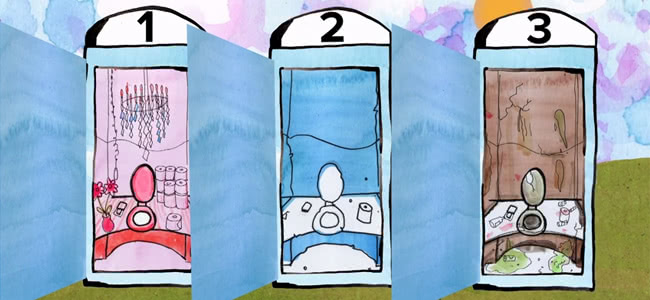“If there’s one thing that links all music festivals, from the biggest of marquee international events to the trendiest of local boutique gatherings, it’s the toilets.
While some are better than others, chances are you’d prefer a clean porcelain escape with all the facilities to do your business any day of the week over the sawdust-ridden drop toilets or grimy portaloos festivals offer.
But that’s just simply not the case and even the most seasoned of attendees will tell you that some of the worst music festival nightmares are less to do with losing tent pegs or your mates in the crowd than submitting yourself to a nasty excrement-stained plastic prison when nature calls.
There’s a solution to this common potty problem however, which should help reduce the chances of you ending up in the music festival equivalent of that horrific cubicle from Trainspotting.
The secret weapon? Mathematics.
Introducing the good and brainy people who run YouTube channel Numberphile, who regularly use the power of arithmetic to tackle everyday problems in inventive ways (eg. calculating Pi with real pies, or the most scientific way to share cake). They’ve now turned their attention to figuring out how to get the best (re: the least scummy) toilet at a music festival, as Consequence Of Sound reports.
For the non-numbers minded among you, it’s a bit confusing and might just cause a headache, but if you’re curious, the Numberphile-produced video is designed to give you the best chance of ending up in the most sanitary toilet through a formula of mathematical probability, as presenter Dr. Ria Symonds of the University of Nottingham details.
[include_post id=”263141″]
There’s two key factors at play in her maths experiment. Specifically, a) the best toilet is defined as the cleanest (stocked with paper, sanitizer, and fewer smelly oddities) and b) if you pass on a toilet in the hope of something better, you can’t go back to it because of all those bladder-bursting punters behind you.
But “the problem is, you’ve got hundreds of these toilets”, says Dr. Symonds. “How do you know to know which toilet to step on and use that one. So you don’t have to try them all, there must an optimum number we can look at.”
To illustrate her method – with the help of some cute animation – the Nottingham scholar proposes an imaginary festival model using three toilets: 1 is the cleanest, 2 is slightly worse but useable, and 3 is a fecal nightmare. Realistically they won’t be ordered ‘1, 2, 3’ so there will be six permutations of how these three toilets are ordered. The odds of hitting toilet #1 on the first chance are very slim, but Dr. Symonds suggests that if you reject the first toilet – no matter how clean – and go for the next best looking toilet, then overall you’ll end up with a 50% chance of getting that #1 toilet (eg. a 3/6 chance in those six permutations).

What about four toilets? Well, now you have 24 permutations but stick to the same principle of ‘always rejecting the first, no matter how good it is’, you get a 46% (or 11/24) chance of getting the best possible/cleanest #1 toilet. That means the larger the quantity of toilets on site, your chances of getting #1 are reduced by 4%.
Of course no festival has just four toilets (imagine the queues!), but by applying the same method of “reject the first, choose the best so far” to large-scale events means you’ll only have to look inside 37% of the toilets and then take the next one after that is ‘best so far’ to give you the best chance of ending up in the best toilet. eg. if there’s 100 toilets, look and skip over the first 37 then choose the next best one for your best chance at some toilet nirvana.
Still confused? We don’t blame you, but watch the full video below (and the extended cut with all the head-grinding maths at bottom) for a better understanding that might just give you the edge next time you’re queued up in the heat during the summer music festival season. That or get to Splendour In The Grass’s Byron Bay site early and scope out all the loos first, yeah?




































